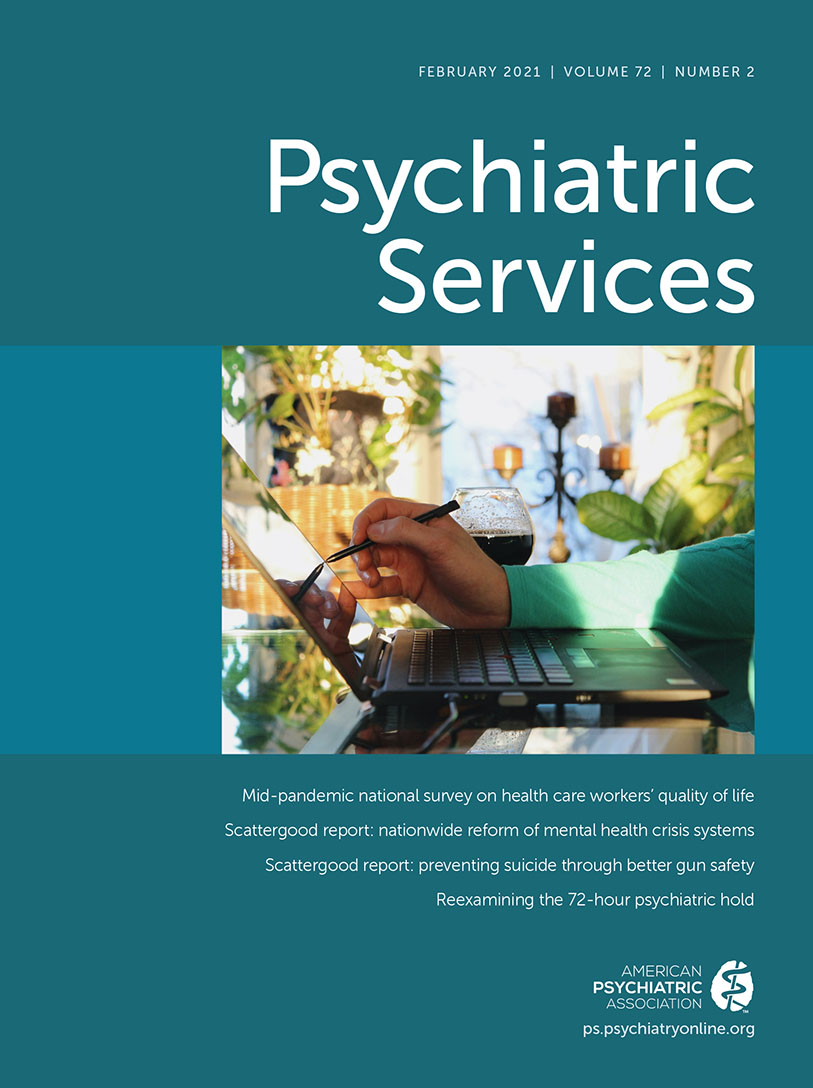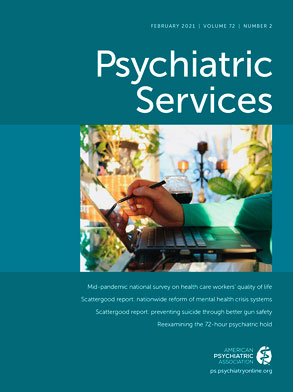In study after study, more than 50% of those with common mental disorders voice a preference for including psychotherapy in their mental health care (
1). Less is known about treatment preferences among people with serious mental illness, but this population similarly extols the importance of psychosocial treatment in combination with psychotropic medication (
2). Substantial gaps exist in the receipt and quality of mental health treatment in the United States. Claims data suggest that delivery and utilization of evidence-based psychotherapy (EBP) are often inadequate when compared with the benchmarks laid out in clinical guidelines (
3) and that psychotherapy assumes a less prominent role in mental health care as exclusive use of pharmacotherapy increases (
4). Although access to all mental health services is challenging, accessing EBP is particularly difficult and could be ameliorated by policies that enhance availability. Specifically, these policies include stakeholder agreement on best practices; the requirement of competency-based training, credentialing, and continuing education; implementation of process measures to assess service quality; integration of services into nontraditional venues; and incentivization of best practices. This Open Forum is inspired by a chapter from the
Palgrave Handbook of American Mental Health Policy (
5), in which each of these points is discussed in greater detail. Our intended audience is broad, encompassing all stakeholders in a position to advance changes to mental health policy—educators, administrators, accreditation bodies, health care agencies, professional organizations, policy makers, and others. Although each point deserves elaboration, here we enumerate these interconnected difficulties in implementing psychotherapy in the United States to stimulate future discussions on this matter.
Agreement on What Constitutes Best Practices
Among the biggest challenges in the United States is that no single advocacy group, professional organization, or credentialing body is responsible for regulating policies on best practices for psychotherapy. Although various organizations have conducted systematic reviews and meta-analyses of the evidence base for these interventions, these reviews often use disparate evaluation methods and, as a result, may provide conflicting information about what is or is not a best practice (
6). This confusion creates substantial difficulties for policy makers when deciding on what should be supported, resulting in questions with regard to education (What should psychotherapy programs teach?), credentialing (What should practitioners be evaluated on?), quality measures (What should a system of care evaluate?), expanding access (Where and how to deliver care?), and, finally, how to appropriately reimburse and incentivize the care being delivered (What to pay for, and how?). This singular failure to agree on what constitutes a best practice impairs the whole process of psychotherapy implementation.
Over 40 countries have overcome this particular challenge by adopting the methods of the National Academy of Sciences and the Guidelines International Network (
7). Such guidelines are based on systematic reviews written by a multidisciplinary, independent panel of experts who rigorously grade and synthesize the evidence base using a standardized approach. One such example of using guidelines to promote adoption of EBP is the United Kingdom’s Improving Access to Psychological Therapies (IAPT) program. IAPT delivers EBPs for depression, anxiety, and posttraumatic stress disorder as recommended by the U.K. National Institute for Health and Care Excellence (NICE). This program serves as an international model for improving access to services and bridging the research-practice gap. Indeed, most patients enrolled in IAPT services realize clinically meaningful benefits (
8). However, a common complaint about the guideline process is that it is not nimble enough to accommodate scientific advances. For example, NICE conducts systematic reviews every 10 years, meaning its guidelines may become outdated. This challenge can be addressed through better partnerships among federal agencies and organizations, such as the National Institute of Mental Health (NIMH) and Substance Abuse and Mental Health Services Administration (SAMHSA). A recent example of this success is the RAISE project for early psychosis (
9). Even before the results of the trial were published, NIMH and SAMHSA began to partner with state agencies to implement this best practice of coordinated specialty care. A combination of high-quality systematic review procedures and opportunities to implement practices with strong evidence as soon as they are ready to deploy can serve as a nimble and efficient method for guiding policy changes.
Competency-Based Training, Credentialing, and Continuing Education
Clinical training programs are free to determine what constitutes best practice and how to develop and assess competencies among trainees. Interestingly, psychiatry residency training programs are more likely to require training in EBPs than are social work and psychology training programs (
10). Very few programs rely on educational best practices, such as competency-based observational methods (e.g., those of Stirman et al. [
11]) and behavioral rehearsal (e.g., that of Beidas et al. [
12]). This unnecessarily transfers the onus of EBP training onto mental health care organizations, which end up investing in costly and time-consuming workforce retraining efforts.
Credentialing of mental health providers varies by state. All applicants for licensure have to complete a national examination of knowledge in their field and attest to coursework and supervised clinical experiences; however, states vary in the amount of additional testing required. For example, most states require only an additional jurisprudence exam, whereas others require further demonstration of competency. However, there are no national competency tests akin to what medical providers undergo. To be eligible for a medical license, a multistep national examination links a physician’s knowledge with an applied test of broad clinical skills, such as a patient interview and the basics of a physical exam. The same is true for continuing education. Similarly, maintenance of physician board certification requires practice-based learning and practice performance assessment. In contrast, there are few restrictions on what constitutes a continuing education activity for nonphysician mental health providers. Usually, the clinician attests to a specified number of hours in continuing education coursework, with no required demonstration of competency.
One example of a model for workforce training is the Veterans Health Administration (VHA) Mental Health Initiative Operating Plan, in which clinicians are required to demonstrate EBP competencies for a variety of behavioral health and substance use disorders (
13). The VHA initiative includes provider trainings, audit and feedback of clinical cases, and ongoing consultation of actual cases with a psychotherapy expert. Although systematic implementation of this program was challenging, the VHA ensures that clinicians could competently deliver psychotherapy and receive continuing education with experts in these practices.
Devising Better Quality Measures
Clinician EBP competence is associated with improved outcomes for clients (
14), which, in turn, may lower health care costs (
15). Currently, patient-reported outcomes and patient satisfaction ratings are used by many U.S. health care organizations as quality measures, yet these measures do not directly assess clinician competency or therapist adherence to EBPs (
6). We argue that better process measures of quality are needed and that patient-reported outcomes are necessary but not sufficient. Patient-centered quality metrics should include not only symptom outcomes but also assessment of patient and family satisfaction with care and alignment of care with patients’ goals (
16). We appreciate the complexity of this issue and recognize that multiple entities are at work to develop, test, implement, monitor, and regulate quality measures. Ideally, assessment of process and other measures of quality can highlight ways to improve EBP availability.
Next Steps
We note that several policy reports have echoed the observations made here, but all of them have stopped short of making actionable recommendations. Indeed, one of the earliest reports on these challenges was written in the late 1980s; to date, there has been very little systematic action in the United States to address EBP access. Even a recent Institute of Medicine (now National Academy of Medicine) report on this problem stopped short of making firm recommendations (
6). Given the high morbidity and mortality rates due to mental illness, policy makers need to rally around solutions to address this public health challenge, in much the same way as local and state policy makers have tried to address the current COVID-19 pandemic. Rather than waiting for action by the federal government, local and state governments should innovate to address the specific challenges and needs in their communities. Multiple levels of policy makers need to band together with scientific experts, payers, professional organizations, employers, and consumers to agree on practice guidelines, educational and credentialing policies, novel access methods, and measures of quality tied to meaningful incentives. Ultimately, our recommendations are a call to action for diverse stakeholders to ensure that EBPs are available and accessible and aligned with patient preferences.

